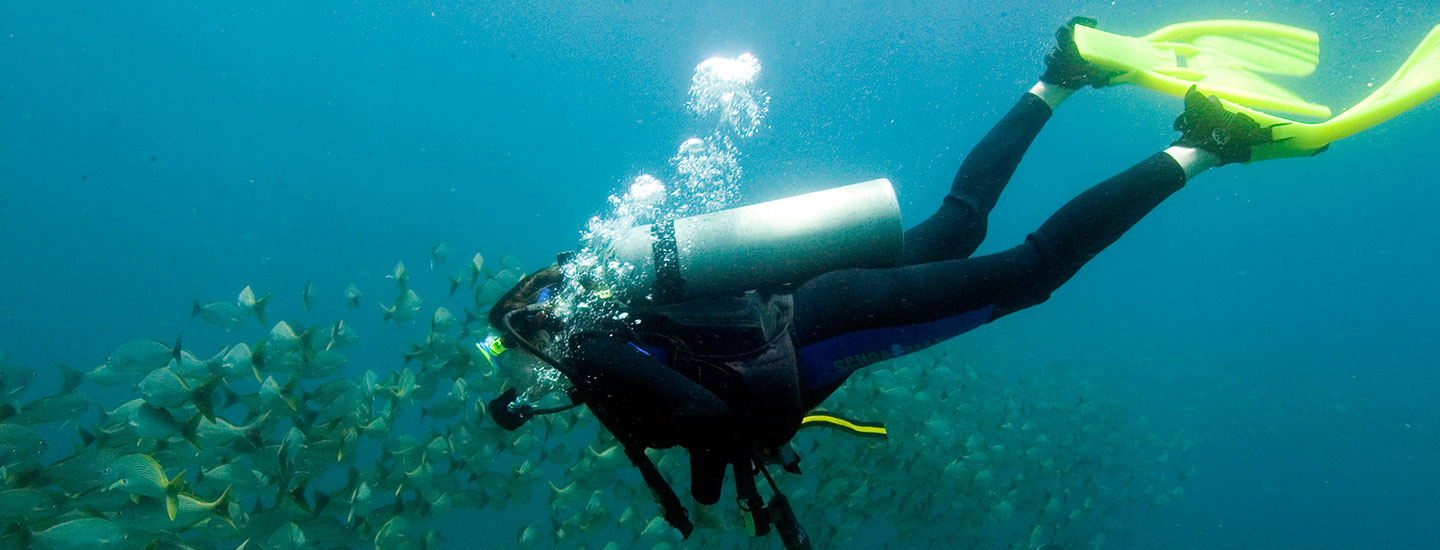
Diving in
Costa Rica
Come to discover an undersea world of extraordinary beauty
Spectacular shades of color greet divers as they explore pristine coral reef formations.
Winner of Rodale 's Scuba Diving Magazine’s 2004 Readers' Choice Award, Costa Rica's Pacific coast is listed as a top five destination for advanced scuba diving.
Costa Rica facilitates your diving experience in a number of ways:
- Professional diving tour companies offer services, equipment and accessories, and everything else needed for a safe and fun diving experience.
- Open water diving courses are also available from beginners up to instructor level, as well as classes for physically disabled persons. All are offered in accordance with PADI (Professional Association of Diving Instructors, located in California, United States), NAUI (National Association of Underwater Instructors) and SSI (Scuba Schools International) among others.
- Comfortable, high-quality accommodations to suit every budget.
Some important tips to ensure a safe and fun diving experience:
- Look for reputable companies representing well-established associations and seek out operators with valid permits.
- Verify each ship has the emergency equipment required by law.
In Costa Rica, diving is regulated by the Adventure Tourism Regulation. This same site may be visited when searching for the available diving tours in Costa Rica.
Guanacaste region
In Guanacaste region, Costa Rica has a wide variety of activities for all tastes and ages.
Puntarenas and the gulf islands
The country's exemplary system of National Parks and Protected Areas provide fertile grounds for bird watching, but just about anywhere in Costa Rica, spectacular avian species, including blue-grey tanagers, great kiskadees and crimson-fronted parakeets are abundant. True birders will want to take a trip to the cloud forests of Monteverde to see the resplendent quetzal or to the Central Volcanic Mountain Range to see the equally spectacular scarlet macaw.
Cocos island
This world-famous National Park was established in 1978. In 1997, UNESCO declared it a World Natural Heritage Site.
Located on the Pacific side of Costa Rica, 543 km of Cabo Blanco, Cocos Island is a real treasure for divers and day-trippers alike. The journey takes approximately a day and a half but is well worth it for lovers of natural environments and exotic marine life. To visit Cocoss Island, contact a tour operator to organize your trip.
Central Pacific
Only a few hours from San José, the Central Pacific region, with its impressive rock formations and underwater caves found in places like the Manuel Antonio National Park, offer ideal diving conditions.. The beautiful waters at Cathedral Point, Puerto Escondido, and the Mogote and Olocuita Islands also wait to be expored.
South Pacific region
The most representative dive site in this area is the Caño Island Biological Reserve, located approximately forty-five minutes from Drake Bay on the Osa Peninsula, where you will find a very difficult-to-compare marine ecosystem. You can also explore the islets Tres Hermanas and the protected maritime Zone of the Marino Ballena National Park, which houses a great diversity of coral species and in which the migrations of humpback whales (Megaptera novaeangliae) stand out.
South Caribbean region
Protected by the Gandoca-Manzanillo Wildlife Refuge, and the Cahuita National Park, this mostly unexplored region features a fantastic coral reef ecosystem surrounded by mystical waters
Costa Rica's best places for diving
On the map you'll find Costa Rica's tourism regions, where you can participate in these activities. For more information on any of these activities, contact your travel agent or hotel.
